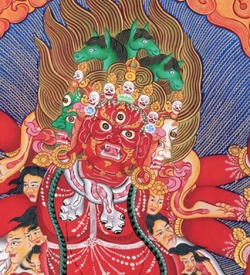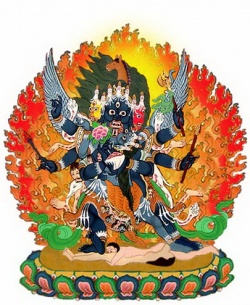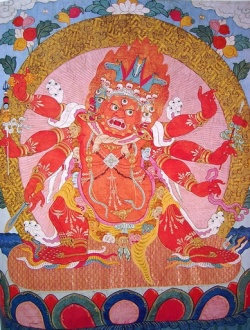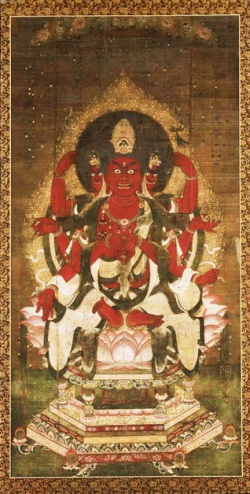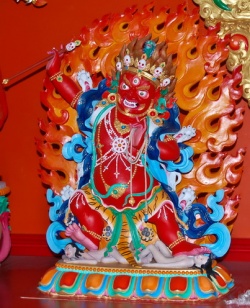Hayagreeva the embodiment of higher intelligence
Hayagreeva is an incarnation of Vishnu, depicted with a human body and a horse's head, brilliant white in color, with white garments, seated on a white lotus.
Hayagriva is a horse-headed deity present in Hinduism and Buddhism.
In Hinduism, Hayagriva is an avatar form of Vishnu, as described in the Bhagavata Purana, representing knowledge and wisdom.
Various legends surround Hayagriva: In some sources he is a white horse who pulls the sun into the sky every morning. In others, such as the great epic Tārakā-battle, Vishnu appeared as a ferocious warrior called Hayagriva when the gods were under attack from the dānava’s demons.
In Tibetian Buddhism, Hayagriva is the wrathful Amitabha, the deity of speech. He is a Dharmapala, and one of the eight main dharmapalas, alongside Mahakala, Yama, Yamantaka, Vaisravana, Palden Lhamo, Tshangspa Dkaro, and Begste. In Japanese Buddhism, he is called Bato Kannon, the horse headed aspect of Kannon Bodhisattva (Avalokitesvara) who protects those who are reborn in the animal realm.
Though present within both Hinduism and Buddhism, Hayagriva embodies distinctively different aspects and mythology between the two religions, and should be considered as separate entities.
"A bodhisattva in Buddhist teachings, known in Japan as "Batou-Kannon" or "Shishi-Mui-Kannon." His name means "Horse's Head" or "one with a horse's mane."
Hayagriva is counted among the six aspects of Avalokitesvara. He has a wrathful appearance. He is the bodhisattva of destroying evil and of eradicating ignorance and harmful thoughts.
While Avalokitesvara usually wears a serene expression, Hayagriva's face is grim, with bared fangs. He is also sometimes considered one of the Eight Vyaraja.
These days, it is common to build a statue of Hayagriva on the street corner when a horse suddenly dies. A marker carved with Hayagriva's name is often placed near racetracks to commemorate horses who have died racing."
Hayagriva is worshipped in Tibet principally by horse dealers because he is believed to frighten away demons by neighing like a horse. When invoked, he is said to announce his coming by neighing, which accounts for the presence of a horses head, his distinctive mark, in his head dress. The horses head neighs loudly, and the sound is said to pierce all false appearances of substantiality, revealing the shining reality of freedom. His mantra contains the following verse:
"I request that you protect all horses. Increase the number of mares. For from the mother of the horse many supreme horses will be born. Please disperse the obstacles on the Path and reveal the right direction."
Hayagriva is a wrathful manifestation of Avalokiteshvara. There are believed to be 108 forms of Hayagriva. His special ability is to cure diseases, especially skin diseases even as serious as leprosy, which is said to be caused by the Nagas (malignant water spirits with serpent bodies).
One may think that Padmasambhava was only founding master of Nyingma lineage non related to Gelukpa, actually not. Padmasambhava was the one who started Dharma over Tibet. This stream of Hayagriva practice, originated from Padmasambhava, is very popular in Gelukpa. This practice was passed down from Padmasambhava to a master called Dpon Ston Skyur Gang Pa (Onton Kyergangpa?), and be unbroken since then. It was not the time of Padmasambhava’s actual physical activities when Padmasambhava passed this practice to Dpon Ston Skyur Gang Pa. Dpon Ston Skyur Gang Pa was an early master of Shangpa Kagyu who had high attainment. He could go to different places under the ‘Dream Body’. In order to seek for a practice which can subdue obstacles and nagas, he used the ‘Dream Body’ coming to Padmasambhava.
Padmasambhava gave him the Hayagriva initiation and advised him to go to Lhasa region looking for a Yogi named Naljorpa who also practiced Hayagriva. Padmasambhava has hidden a special Hayagriva dharma wheel there which can only be discovered by Naljorpa. Dpon Ston Skyur Gang Pa came to this region, found Naljorpa, got the dharma wheel and learnt the way to make it. Starting from Dpon Ston Skyur Gang Pa, this stream of Hayagriva practice and the special way to make the dharma wheel was passed down to Je Tsongkapa and further down to other gurus. ......Although this practice belongs to HYT, but the nature is a bit different from Yamantaka etc. deities and be more opened in transmission. In Tibet, whoever faced obstacles, no matter received Hayagriva initiation/oral transmission or not, can recite this deity’s mantra. extrated from Khejok Rinpoche's teachings.
In his simplest form he is depicted with one face, two arms and two legs. Everything about him is terrific his scowling face with three glaring eyes, his roaring mouth with protruding fangs, his pose of warriors aggressiveness, his broad belly bulging with inner energy, his sword raised threateningly in his right hand, his left hand raised in a threatening gesture and his snake ornaments. His beautiful, terrific aspect expresses compassions fierce determination to help us overcome inner egotistic addictions and outer obstructions.
Hayagreeva is a very important deity in the Vaishnava tradition. His blessings are sought when beginning study of both sacred and secular subjects. Special worship is conducted on the day of the full moon in August (Sravana-Paurnami) (his avatara-dina) and on Mahanavami, the ninth day of the Navaratri festival. He is also hailed as "Hayasirsa". HayaSirsa means haya=Horse, Sirsa=Head.
One of the legends states that during the creation, the demons Madhu and Kaithaba stole the Vedas from the creator Brahma, and to save them Vishnu took the form of Hayagreeva. This story represents the triumph of pure knowledge, guided by the divine over demonic forces of darkness.
Legends of Hayagreeva
Vedanta Desika's dhyana-sloka (meditative verse) on Hayagreeva typifies this deity's depiction in Hindu iconography:
"He has four lotus hands, with one in the mode of bestowing knowledge; another holds books of wisdom, and the other two hold the Conch and Discus. His beauty, like fresh cut crystal, is an auspicious brilliance that never decays. May this Lord of speech who showers such cooling rays of grace on me be forever manifest in my heart! In the [[Mahavairocana-sutra [Sutra]] of the Great Sun) translated and copied in 1796 by I-hsing it says: "Beneath the buddhas is Hayagriva. His body is the color of the sun at dawn. He wears flaming effulgence and skulls as a garland. His nails are long and sharp; his face shows a pair of bare tiger's fangs. His hair is that of a burning lion's mane. He is awesomely powerful and fierce! This is the fierce Vidyaraja (wrathful vehicle) of the Lotus section.
He is just like a horse-jewel of a Cakravartin that wanders the four continents, nowhere and never does he rest, having all the great and terrible force of all the buddhas'. This is his nature, and therefore he possesses this terrible and all-mighty light. Amidst the greatest obstacles of death and evil he is without the slightest care for his own welfare, his conspicuous and uncommon gallantry, intrepidity, and wrath is legendary among the gods, and therefore he easily and quickly vanquishes all who oppose him! Many others submit to him at first sight! This is because though he is fierce and terrible; his heart is full of compassion (unbiased, dispassionate understanding)." -- Hayagriva Stotram, v.32
Later on Hayagreeva is referred to as the "Horse necked one", "Defender of Faith", the "Terrible Executioner", the "Excellent Horse", and the "[[Aerial horse".
This said, the Horse god is seen as pulling the sun up to the heavens every day, bringing light to darkness. Hayagreeva's consort is Lakshmi (Marici or Kan'non), the goddess of the rising sun, more accurately the sun's light which is the life force of all things, and which is seen as the female [in, yin] aspect of Hayagreeva. This relationship is the classic non-duality of the Hindu Tantra. Marici represents the essence of the power of creation of the cosmos, and is the in/yin half of Dainichi Nyorai. Whereas, Hayagreeva represents the other yang/yo aspect, that of the manifestation of the power of yin/in as action.
In other words, Hayagreeva represents the manifestation of yin/in as the power and action of the cosmos manifested as action. This is the very definition of Tantra, that of action.
In several other sources he is a white horse who pulls the sun into the sky every morning. In others such as the great epic Taraka-battle where the gods are fallen on and attacked by the danava's [[[Wikipedia:demons|demons]]], Vishnu appears as the great ferocious warrior called Hayagreeva when he comes to their aid. It says;
"Hayagreeva appears in his chariot, drawn by 1,000 powerful steeds, crushing the enemies of the gods beneath him!"
There are many other references to Hayagreeva throughout the Mahabharata. It is said that Vishnu comes from battle as a conqueror in the magnificent mystic from of the great and terrible Hayagreeva;
"The great Hayagreeva having been praised in this way by the different saints and ascetics, assumes a great white horses head. The veda's (mantras) made up his shape, his body built of all the great gods; in the middle of his head was Shiva, in his heart was Bhrama (god of heaven); the rays of sun (Marici) were his mane, the sun and moon his eyes; the Vashu's and Sadhya's were his legs, in all his bones were the gods. Agni [Ka-ten; god of fire) was his tongue, the goddess Satya his speech, while his knees were formed by the Maruts and Varuna. Having assumed this form, a awesome wonder to behold to the gods, he vanquished the asura, and cast them down, with eyes that were red with anger."
Invariably, Hayagreeva is depicted seated, most often with his right hand either blessing the supplicant or in the vyaakhyaa mudraa pose of teaching. The right hand also usually holds a aksha-maalaa (rosary), indicating his identification with meditative knowledge. His left holds a book, indicating his role as a teacher. His face is always serene and peaceful, if not smiling.
Unlike his Buddhist counterpart, there is no hint of a fearsome side in the Hindu description of this deity. Indeed, the two deities seem to be totally unrelated to one another. Hayagreeva is sometimes worshipped in a solitary pose of meditation, as in the Thiruvanthipuram temple. This form is known as Yoga-Hayagreeva. However, he is most commonly worshipped along with his consort Lakshmi and is known as Lakshmi-Hayagreeva. Hayagreeva in this form is the presiding deity of Mysore's Parakala Mutt, a significant Srivaishnava monastic institution.
What does Hayagreeva represent?
Hayagreeva is an embodiment of intelligence and knowledge. He is a divine being who gives divine intelligence and wisdom. Hayagreeva can also bestow siddhi (Supernatural) powers on you when you connect with his divine energies, with sincerity.
The story of Hayagreeva retrieving the Vedas represents triumph of pure knowledge, guided by the divine, over forces of passion and darkness.
Hayagreeva is an important deity in Vaishnava tradition. His blessings are sought when beginning study of both sacred and secular subject.
Personal Practices
Chant the Quantum Sound Frequency given by Dr. Pillai to invoke Hayagreeva's blessings and grace in your life.
OM AKSHARESHVARAYA VIDHMAHE
MANTRA RAJAYA DHEEMAHE
TANNO HAYA GREEVA PRACHODAYAAT
Alternatively Chant:
Haya Greeva, Haya Greeva, Haya Greeva (pause) and continue
Get a Shiva-Shakti mala, made from rudraksha/crystal beads, and chant this frequency 108 times daily.
